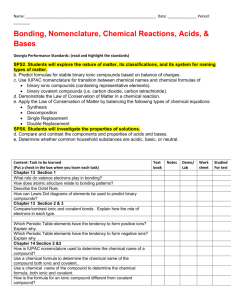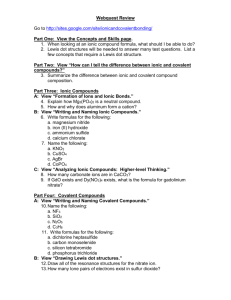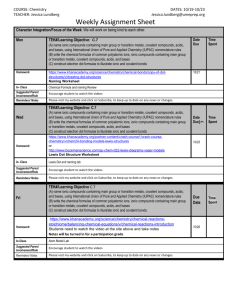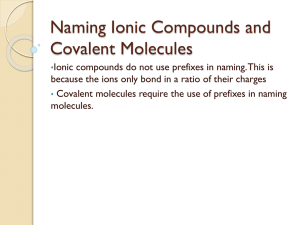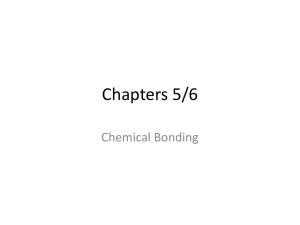jeopardy ionic covalent 2.25.13
advertisement
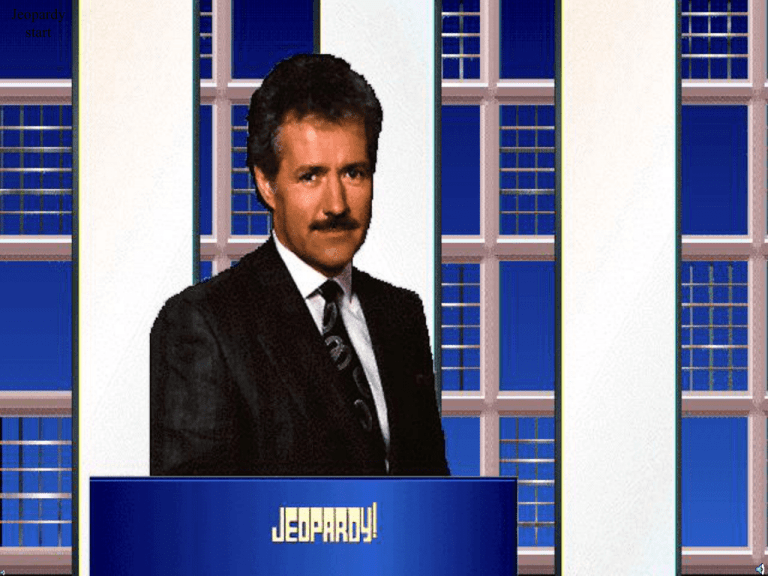
Jeopardy start Ionic Compounds Covalent Compounds Ions Naming Ionic Compounds Naming Covalent Compounds Miscellaneous Game board Ionic Compounds Covalent Compounds Ions Naming Ionic Compounds $100 $100 $100 $100 $200 $200 $200 $200 $300 $300 $300 Naming Covalent Compounds Misc. $100 $100 $200 $200 $300 $300 $300 $400 $400 $400 $400 $400 $400 $500 $500 $500 $500 $500 $500 1 - 100 1-100 The strong attractive force between two oppositely charged ions. 1 - 100 1-100A What is an ionic bond? 1-200 The ratio a magnesium and iodide ion would combine in. 1 - 100 1-200A What is 1:2? 1-300 Ionic compounds have _______ melting and boiling points. 1 - 100 1-300A What is high? 1-400 The well organized structure of repeating ions of opposite charges in all directions. 1 - 100 1-400A What is a crystal (lattice)? 1-500 The ratio calcium and nitride would combine in. 1 - 100 1-500A What is 3:2? 1 - 100 2-100 Two nonmetals sharing electrons. 1 - 100 2-100A What is a covalent bond? 2-200 The state of matter covalent compounds are typically at room temperature. 1 - 100 2-200A What is gas? 2-300 The force between particles of a substance. 1 - 100 2-300A What is an interparticle force? 2-400 When three pairs of electrons are shared between two nonmetals. 1 - 100 2-400A What is a triple bond? 2-500 The smallest unit of a covalent compound. 1 - 100 2-500A What is a molecule? 1 - 100 3-100 An atom or group of atoms that have a charge because of the loss or gain of electrons. 1 - 100 3-100A What is an ion? 3-200 The charge of a sodium ion. 1 - 100 3-200A What is +1? 3-300 The charge of phosphide. 1 - 100 3-300A What is -3? 3-400 This rule says that an atom becomes stable by having eight electrons in its outer shell. 1 - 100 3-400A What is the octet rule? 3-500 The complete electron configuration of sulfide (not noble gas short cut). 1 - 100 3-500A What is 2 2 6 2 1s 2s 2p 3s 6 3p ? 1 - 100 4-100 LiF. 1 - 100 4-100A What is Lithium Fluoride? 4-200 Chromium (III) Fluoride. 1 - 100 4-200A What is CrF3? 4-300 Calcium Sulfate. 1 - 100 4-300A What is CaSO4? 4-400 Cu(NO3)2. 1 - 100 4-400A What is Copper (II) Nitrate? 4-500 Ammonium Phosphate. 1 - 100 4-500A What is (NH4)3PO4? 1 - 100 5-100 H2O. 1 - 100 5-100A What is Dihydrogen Monoxide? 5-200 Sulfur Trifluoride. 1 - 100 5-200A What is SF3? 5-300 C3Br5. 1 - 100 5-300A What is Tricarbon Pentabromide? 5-400 SeCl6. 1 - 100 5-400A What is Selenium Hexachloride? 5-500 N7I10. 1 - 100 5-500A What is Heptanitrogen Decaiodide? 1 - 100 6-100 This type of compound has a metal in it. 1 - 100 6-100A What are ionic compounds? 6-200 Between ionic and covalent compounds, this type has the lower melting point. 1 - 100 6-200A What are covalent compounds? 6-300 When an atom loses an electron, it becomes this type of ion. 1 - 100 6-300A What is a cation/positive ion? 6-400 The alkaline earth metals form this charge as ions. 1 - 100 6-400A What is +2? 6-500 The prefix for 9 atoms. 1 - 100 6-500A What is “nona”? Divide the following into two lists: one for ionic and one for covalent compounds. Then name them. PCl5 ZnCl2 NH4F C2O3 Ionic: ZnCl2 – Zinc chloride NH4F – Ammonium fluoride Covalent: PCl5 – Phosphorus Pentachloride C2O3 – Dicarbon trioxide


